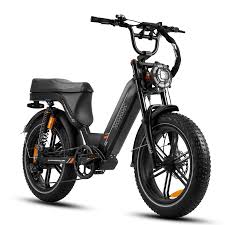Factors Influencing E-Bike Range
1. Battery Capacity
The battery is the most critical component influencing an e-bike’s range. Battery capacity is measured in watt-hours (Wh), which represents the amount of energy the battery can store. A higher watt-hour rating generally means a longer range. For instance, a 500Wh battery will typically allow for longer rides than a 300Wh battery under similar conditions.
2. Motor Efficiency
The efficiency of the electric bike motor affects how far you can travel on a single charge. Efficient motors convert more of the battery’s power into forward motion. There are two main types of e-bike motors: hub motors and mid-drive motors. Mid-drive motors are generally more efficient as they use the bike’s gears to optimize power usage, especially on hilly terrain.
3. Level of Pedal Assist
E-bikes offer various levels of pedal assist, which determines how much the motor helps with pedaling. Higher levels of assist use more battery power and therefore reduce the range. Conversely, using lower levels of assist or riding without any motor support conserves battery life and extends the range.
4. Terrain and Riding Conditions
Terrain significantly impacts the range of an e-bike. Riding on flat surfaces requires less power compared to hilly or uneven terrain. Additionally, riding conditions such as wind resistance play a role. Headwinds increase power consumption, while tailwinds can help conserve battery energy.
5. Rider Weight and Cargo
The combined weight of the rider and any additional cargo affects the e-bike’s range. Heavier loads require more power to move, reducing the overall distance the bike can travel on a single charge. Lightening the load or distributing weight evenly can help extend the range.
6. Riding Style
Aggressive riding with rapid acceleration, high speeds, and frequent starts and stops consumes more battery power. Smooth and consistent riding at moderate speeds is more energy-efficient and helps maximize the e-bike’s range.
Typical E-Bike Ranges
Under average conditions, the range of an e-bike can vary based on battery capacity:
- 250Wh Battery: Approximately 20-35 miles (32-56 km)
- 400Wh Battery: Approximately 35-50 miles (56-80 km)
- 500Wh Battery: Approximately 40-60 miles (64-96 km)
- 750Wh Battery: Approximately 60-100 miles (96-160 km)
These estimates assume moderate levels of pedal assist, flat terrain, and average rider weight. Real-world range may be higher or lower depending on specific conditions and how the e-bike is used.
Maximizing E-Bike Range
To get the most distance out of a single charge, consider the following tips:
- Use Lower Levels of Assist: Opt for lower levels of pedal assist when possible.
- Plan Efficient Routes: Choose routes with flatter terrain to reduce power consumption.
- Regular Maintenance: Keep the e-bike in good condition by maintaining proper tire pressure, lubricating the chain, and ensuring all components are functioning correctly.
- Ride Smoothly: Avoid rapid starts and stops, and maintain a steady pace.
Conclusion
The range of an electric bike on a single charge depends on a combination of factors including battery capacity, motor efficiency, terrain, rider weight, and riding style. While general estimates can provide a guideline, actual range will vary based on individual circumstances. By understanding these factors and adopting efficient riding habits, e-bike owners can maximize their bike’s range and enjoy longer rides with fewer recharges.



